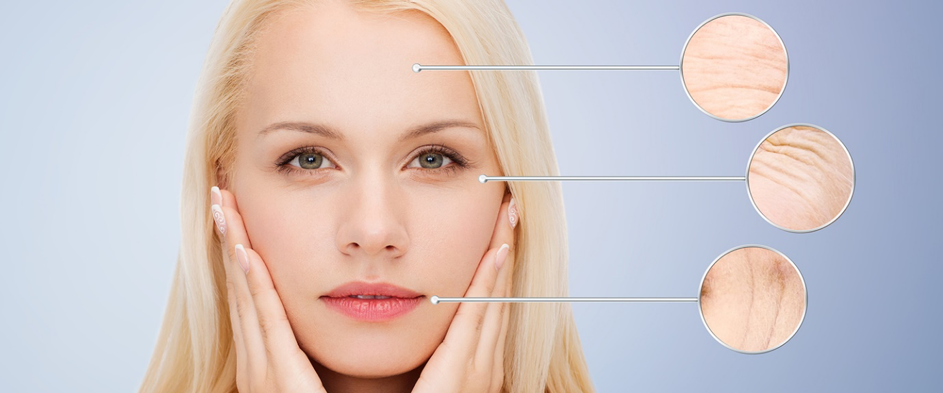We all want to maintain that fresh, glowing face we first saw in the mirror as youths. Collagen injections may be one way to rejuvenate sun-damaged or aging skin. Your skin contains multiple layers. Just below the outer layer (epidermis) is the second layer, called the dermis. This layer has blood vessels, nerves and hair follicles, but it's mostly made up of a protein called collagen.
Collagen is a key support structure in your skin with its network of fibers that provides a framework for the growth of cells and blood vessels.
Collagen also is found in cartilage, teeth and bones.
Collagen fillers will result in a natural look, improving wrinkles, lines and scars. A collagen lip injection will produce a fuller appearance. If the collagen used was from human sources, the area will be overfilled and will look that way at first. But this will soon disperse to yield a more natural look.

In addition to filling in wrinkles and creases, collagen injections can be used to:
- Plump up creased and sunken areas
- Add fullness to your cheeks or other facial areas
- Reduce frown lines between the eyebrows
- Reduce worry lines across the forehead
- Decrease crow's feet at the corner of the eyes
- Treat deep smile lines, called nasolabial furrows, from the side of the nose to corners of the mouth
- Define the lip border
- Eliminate vertical lines on the mouth as well as those at the corners
- Decrease acne scars and other soft facial scars
- Add volume to your lips
Hyaluronic Acid
If you want to reduce facial wrinkles and lines, hyaluronic acid may be a good choice as a dermal filler because of its compatibility with the human body.
In fact, this substance is found in almost every single living thing. In humans, it acts as a network that transfers essential nutrients from the bloodstream to skin cells.
Hyaluronic acid is a natural substance found in your body. High concentrations are found in soft connective tissues and in the fluid surrounding your eyes. It's also in some cartilage and joint fluids, as well as skin tissue. It is extracted and reformulated and now has become one of the most popular kinds of injectable fillers. If the term sounds familiar, it's because the same substance is often injected into the aching joints of people with arthritis to ease pain and provide extra cushioning. Brand names include Captique, Esthélis, Elevess, Hylaform, Juvéderm, Perlane, Prevelle, Puragen and Restylane. Hyaluronic acid is not derived from animal sources.
When this gel is injected, it acts like an inflated cushion to support facial structures and tissues that may have lost volume or elasticity due to normal aging. It also brings water to the surface of skin to keep it looking fresh and supple.
Hyaluronic acid injections can be used to improve the skin's contour and reduce depressions in the skin due to scars, injury or lines. You can see potentially dramatic improvements for:
- Acne scars
- Cheek depressions
- Crow's feet at the corner of your eyes
- Deep smile lines that run from the side of the nose to corners of the mouth (also known as nasolabial furrows)
- Frown lines between the eyebrows
- Marionette lines at the corners of the mouth
- Redefining lip border
- Scars including burns, acne and those caused by wounds
- Smoker's lines; vertical lines on the mouth
- Some facial scars
- Worry lines that run across your forehead
Skin rejuvenation and resurfacing (laser)
Today you have a variety of options when it comes to rejuvenating your appearance. One of the newest is laser resurfacing, which can reduce facial wrinkles, scars and blemishes. Newer laser technologies give your plastic surgeon a new level of control in laser surfacing, permitting extreme precision, especially in delicate areas.
It's all about using beams of light. Laser skin resurfacing is also known as a laser peel, laser vaporization or lasabrasion. Your surgeon uses the laser to send short, concentrated pulsating beams of light at irregular skin. This removes unwanted, damaged skin in a very precise manner one layer at a time. This targeted approach means there are fewer problems with hypopigmentation, or a lightening of skin for procedures such as laser acne scar removal.
The laser beam used in laser resurfacing will remove your outer layer of skin, called the epidermis. It simultaneously heats the underlying skin, called the dermis. This action works to stimulate growth of new collagen fibers. As the treated area heals, the new skin that forms is smoother and firmer.
Laser resurfacing can improve minor facial flaws, such as:
- Fine lines or wrinkles around or under your eyes, forehead or mouth
- Scars from acne or chickenpox
- Non-responsive skin after a facelift
- Aged or sun-damaged skin
- Liver spots
- Improve your complexion if you have yellowish or grayish skin tones
- Warts
- Birthmarks such as linear epidermal nevi
- Enlarged oil glands on the nose
Is it right for me?
It may not be the best choice if you have:
- Active acne
- Very dark skin
- Deep wrinkles
- Excessive or sagging skin
Patients with darker skin tones have a greater risk of healing with darker pigmentation (hyperpigmentation). This may be minimized by use of a bleaching agent after laser skin resurfacing as well.
Results
It's possible that your skin may stay red or pink for up to several months after laser skin resurfacing. You may also be extra sensitive to sunlight for up to a year. Make efforts to minimize sun exposure and use that sunscreen liberally, every day.
Some people who have laser resurfacing may see an immediate difference in the treated skin. That will continue to improve for up to a year. While the effects of laser resurfacing can last for many years, the normal aging process means that wrinkles and expression lines will reoccur. You may repeat laser resurfacing as necessary.

